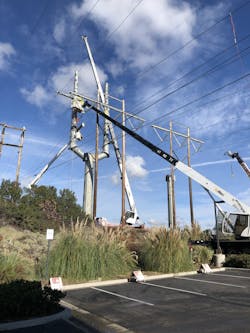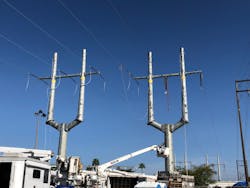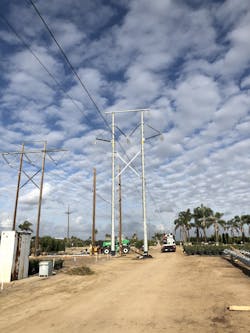Fighting Fire with Steel
Over the past decade, San Diego Gas & Electric Company (SDG&E) has invested more than $3 billion in safety measures to prevent utility-related catastrophic wildfires, including ongoing replacements of over 14,000 wood transmission and distribution poles with fire-resistant steel structures. Currently, SDG&E is working to fire-harden all transmission facilities in its service territory located within the California Public Utility Commission’s (CPUC) identified high fire-threat districts.
While many of the engineering challenges SDG&E faces are common to transmission projects across the country (e.g., schedule, budget, permitting, etc.), constructing in San Diego presents a unique combination of challenges, including environmental, geographical, military and the above-mentioned wildfire considerations. The resources required to tackle these ambitious goals are significant and include a dedicated team of SDG&E civil engineers that design cost-effective solutions to these challenging engineering problems.
A recently upgraded double circuit 230kV, transmission corridor (TL23001/TL23004) illustrates SDG&E Transmission Engineering and Design’s approach using self-
supporting, modified H-Frame tangents, three-pole deadends, and Y-Frame deadend structures.
SDG&E Territory
SDG&E’s territory covers approximately 4,100 square miles in San Diego and south Orange Counties. Its territory includes deserts, canyons, lagoons, grasslands, forests, hills, snow-covered mountains, and more than 70 miles of coastline. This varied topography has many engineering constraints on its own, but it also presents several environmental challenges. In fact, San Diego County is the most biologically diverse county in the continental United States. All this biodiversity makes San Diego County home to hundreds of endangered and protected plant and animal species—the most in the nation. Construction activity of any kind requires exceptional care from all parties, including the design team.
Contrary to popular belief, San Diego isn’t always 75°F and sunny (although it probably is today). In fact, SDG&E operates America’s largest utility-owned weather network of over 220 weather stations due to its climate variability. With SDG&E’s expansive topography and elevation differences, two distinct district loadings are required per the California Public Utilities Commission, Overhead Electric Line Construction Requirements—Heavy (0°F, 6 psf, 0.5 in. ice for elevations greater than 3,000 ft.) and Light (25°F, 8 psf, 0 in. ice for elevations less than 3,000 ft.). Additionally, SDG&E designs for three distinct peak wind conditions caused by Santa Ana winds (65 mph, 85 mph, and 111 mph).
San Diego is home to several military bases. Many people are familiar with Camp Pendleton and the U.S. naval bases in Coronado, Point Loma, and San Diego. The TL23001/TL23004 project, however, is near a different historic military base, Marine Corps Air Station Miramar—the former home of the United States Navy Strike Fighter Tactics Instructor program, better known as “TOPGUN.” As one can imagine, construction and maintenance activities on military facilities require additional permitting and security. Construction near air stations, particularly transmission construction, introduces additional height restrictions to ensure air spaces are free from obstructions.
Preventing Wildfires
SDG&E is a national leader in utility wildfire mitigation and works diligently to develop a comprehensive wildfire safety program to protect its customers and communities. For transmission design, SDG&E actively replaces existing guyed wood pole structures with self-supporting steel structures with expanded phase spacing capable of withstanding local wind conditions.
Wildfire constraints also extend into maintenance and constructability. Compliance and maintenance within the CPUC high fire-threat district is on an accelerated timeframe. All construction, maintenance or otherwise, requires dedicated fire monitoring or is restricted whenever there is a high fire potential.
The safety of its customers, employees, and the communities it serves is SDG&E’s highest priority. All the above considerations are necessary to provide customers with reliable and safe power while reducing the potential for utility-related wildfires and public safety power shutoff impacts.
TL23001/TL23004 Design
It often holds true that the more constraints a project has, the more precise a design must be. This was the case with the recently constructed TL23001/TL23004. The project consisted of parallel 230kV overhead transmission with freeway and railroad crossings; height restrictions due to permitting and airspace; industrial, commercial, and agricultural spaces; and a portion contained within a military base. Terminal structures were placed approximately every mile and at freeway and railroad crossings to prevent cascade failure and reduce construction and restoration time. Both circuits were equipped with optical ground wire (OPGW) for lightning protection, substation relaying, and system protection.
To meet the company’s fire hardening objectives, the project team had a goal to complete the project within three years. To achieve this schedule and to reduce permitting time, the project team had to create a design that kept structure heights down and groundline disturbance to a minimum within the existing transmission corridor.
Unique structures aren’t necessarily always a great design choice. In fact, having well-established standards, whether Rural Utility Service (RUS) or utility-specific pole framing, leads to design consistency, code compliance, maintenance familiarity, and uniform warehousing and tooling. But sometimes standard framing either doesn’t exist or won’t work. The complexities of the TL23001/TL23004 project required three new pole top configurations for SDG&E: a two-pole tangent structure, a three-pole deadend structure, and a monopole deadend Y-Frame.
Tangent Structure
SDG&E needed a horizontal conductor configuration to keep structure heights down and out of the military flight paths. The tangent structure chosen used a ‘braced post’ - ‘v-string’ - ‘braced post’ configuration that eliminated the need for a phase level crossarm as all attachments are made to the poles themselves.
These braced post and V-string insulators eliminated insulator swing and decreased overall conductor blowout; thus, reducing fire risk due to vegetation contact. This configuration also reduces the overall groundline moment when compared to a traditional TH-230 RUS I-String structure, reducing the pole size and foundation footprint.
Terminal Structure –Three-Pole
Three-pole deadends with slip joints were used at the terminal structure locations in less sensitive environmental areas where space was not as limited. Although not unique to areas with flight path restrictions, the double circuit design resulted in 6-poles bisecting the line angle for the two, 230kV circuits.
Terminal Structure – Y-Frame
As stated earlier, horizontal configuration was required to keep the overall structure height to a minimum. However, the three-pole deadend structure created a challenge for both construction and workforce safety in areas with difficult terrain and environmental sensitivity. The solution to this problem: a Y-Frame terminal deadend. The Y-Frame provided enough working space at each site to both erect the structure and perform future maintenance as it minimized the overall footprint of the structure. This reduced footprint also made sense near local business and industrial space allowing both vehicle and foot traffic.
Engineering the Y-Frame required many considerations not typically found on SDG&E transmission poles. Significant angle between the flanges and shafts had to be considered in detailing to provide clearances for proper welding and bolt installation. To assure that the horizontal arms were connected at the same elevations at both verticals, bolted flanged connections were needed. These flanged connections between the vertical shafts and sloped sections are subjected to significantly higher loads – particularly torsion. The exact distance between the two verticals was not achievable due to manufacturing tolerances combined with large dimensions. As a result, to assure proper fit-up of the horizontal arm between the two verticals, each arm had to be custom made to fit the site-specific Y-Frame structure. Analysis was also atypical due to the additional total length of the members. This, in combination with Y-Frame configuration, required additional care to not exceed deflection limits.
Provisions for climbing these poles were unique due to the transition from vertical shaft, to sloped sections, and then back to verticals while providing sufficient clearances from grade as well as from the conductors.
As discussed earlier, Y-Frames were selected to provide minimum footprint at grade to minimize the effects on parking spaces, roads, and trails. This resulted in a single pier foundation per structure in lieu of two or three foundations per location. This single foundation is subjected to a higher load and has a larger torsion than what would be for multiple foundations. Although the single foundation is larger than the multi-pole foundations in a H-frame or three-pole structure, the overall cost of the single foundation was less than that of the multi-pole foundations.
The unique engineering design completed for the TL23001/TL23004 Y-Frames was also a more novel concept to SDG&E contractor crews during the construction phase of the project. While this configuration differed from standard structures that are typically assembled and installed, crews who performed the work noted both successes and new challenges during this project.
The bolted flange design made installation easier compared to SDG&E’s typical slip-joint configuration. The conductor rigging attachment points on the poles were also well-considered and designed by the pole manufacturer for the crews’ use during installation.
One of the challenges that stemmed from this design was training the optical ground wire conductor down the height of the structure to the splice box location. Due to the locations of the arms, climbing steps, and protruding flanges, there was not a clear path to the OPGW splice box. This required additional engineering coordination to help identify an effective route. Another constructability consideration was that a generally larger work site footprint was required to set the structures due to the size of each pole. These impacts should be evaluated and taken into consideration early on during the project design to ensure constructability success.
The Fight Continues
SDG&E is committed to provide cost-effective designs to ensure clean, reliable, and safe delivery of power to its community. This was the case for the TL23001/TL23004 project. Despite its many challenges, TL23001/TL23004 was safely managed, designed, and engineered in-house by SDG&E staff, introducing a new family of structures to support future designs.
While there is still work to be done to fire-harden SDG&E’s system and reduce public safety power shutoffs, a dedicated team of SDG&E civil engineers will be there to continue to design clean, safe, and reliable power for the communities it serves.
Acknowledgments
A special thanks to SDG&E’s Rowena Agustin (project manager) and Josh Klindt (lead designer).
Andy Domask is a principal transmission design advisor for SDG&E. He has 14 years of experience in transmission and distribution engineering and design. He is a professional engineer in California, Colorado, and Texas. Domask has his Bachelor of Science in Atmospheric and Oceanic Sciences from the University of Wisconsin—Madison.
Cho Tam is the team lead for SDG&E Electric Transmission Design, Standards, and Drafting team. Tam was a principal engineer; a transmission line manager of an engineering, procurement, consulting, and construction company; and held other transmission line engineer positions in two other Fortune 500 utilities. He is a Professional Engineer in Illinois. Tam earned his Bachelor of Science in Civil Engineering from University
of Illinois at Chicago.
Mike Liao is the team lead for Civil/Structural Engineering Support on transmission projects for SDG&E. His group is involved with design, procurement, modification, and construction of transmission structures including foundations. Liao has his Bachelor of Science in Civil Engineering from the University of Illinois at Urbana-Champaign and is a Professional Engineer in California.
Stanislav Dekic is a principal engineer at SDG&E Electric Engineering Civil/Structural Department. He has been involved in the power
generation and transmission industry for 25 Years. He is a professional engineer in California and Wisconsin. Dekic has a Master of Science in Civil Engineering from the University of Illinois at Chicago.
Work published courtesy of San Diego Gas & Electric Company.
About the Author
Andy Domask
Andy Domask is a Principal Transmission Design Advisor for SDG&E. He has 14 years of experience in transmission and distribution engineering and design. He is a Professional Engineer in California, Colorado, and Texas. Andy has his Bachelor of Science in Atmospheric and Oceanic Sciences from the University of Wisconsin—Madison.
Cho Tam
Cho Tam is the Team Lead for SDG&E Electric Transmission Design, Standards, and Drafting team. Cho was a Principal Engineer; a Transmission Line Manager of an engineering, procurement, consulting, and construction company; and held other transmission line engineer positions in two other Fortune 500 utilities. He is a Professional Engineer in Illinois. Cho earned his Bachelor of Science in Civil Engineering from University of Illinois at Chicago.
Mike Liao
Mike Liao is the Team Lead for Civil/Structural Engineering Support on transmission projects for SDG&E. His group is involved with design, procurement, modification, and construction of transmission structures including foundations. Mike has his Bachelor of Science in Civil Engineering from the University of Illinois at Urbana-Champaign and is a Professional Engineer in California.
Stanislav Dekic
Stanislav Dekic is a Principal Engineer at SDG&E Electric Engineering Civil/Structural Department. He has been involved in the power generation and transmission industry for 25 Years. He is a Professional Engineer in California and Wisconsin. Stan has a Master of Science in Civil Engineering from the University of Illinois at Chicago.



